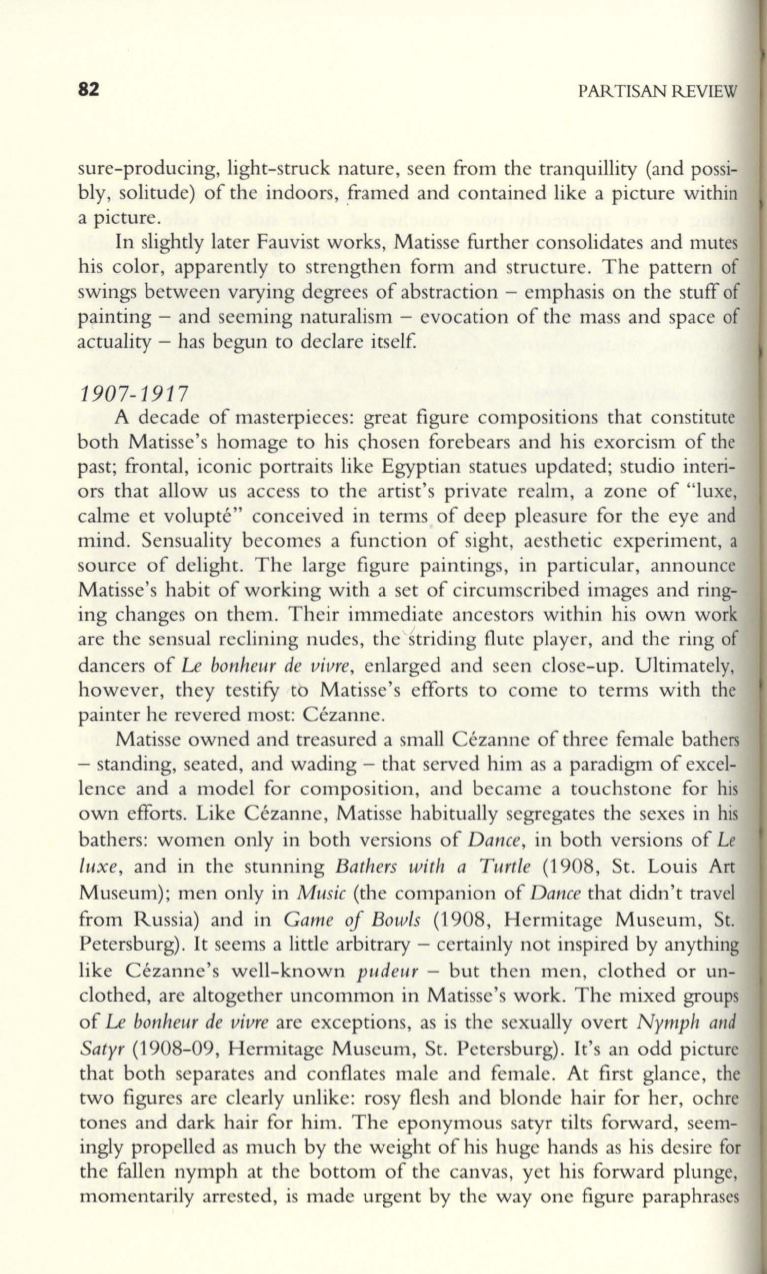
82
PARTISAN REVIEW
sure-producing, light-struck nature, seen from the tranquillity (and possi–
bly, solitude) of the indoors, framed and contained like a picture within
a picture.
In slightly later Fauvist works, Matisse further consolidates and mutes
his color, apparently to strengthen form and structure. The pattern of
swings between varying degrees of abstraction - emphasis on the stuff of
painting - and seeming naturalism - evocation of the mass and space of
actuality - has begun to declare itself
1907-1917
A decade of masterpieces: great figure compositions that constitute
both Matisse's homage to his c;hosen forebears and his exorcism of the
past; frontal, iconic portraits like Egyptian statues updated; studio interi–
ors that allow us access to the artist's private realm, a zone of "luxe,
calme et volupte" conceived in terms of deep pleasure for the eye and
mind. Sensuality becomes a function of sight, aesthetic experiment, a
source of delight. The large figure paintings, in particular, announce
Matisse's habit of working with a set of circumscribed images and ring–
ing changes on them. Their immediate ancestors within his own work
are the sensual reclining nudes, the §triding flute player, and the ring of
dancers of
Le
bonheur de vivre,
enlarged and seen close-up. Ultimately,
however, they testify to Matisse's efforts to come to terms with the
painter he revered most: Cezanne.
Matisse owned and treasured a small Cezanne of three female bathers
- standing, seated, and wading - that served him as a paradigm of excel–
lence and a model for composition, and became a touchstone for his
own efforts . Like Cezanne, Matisse habitually segregates the sexes in his
bathers: women only in both versions of
Dance,
in both versions of
Le
luxe,
and in the stunning
Bathers with a Turtle
(1908, St. Louis Art
Museum); men only in
Music
(the companion of
Dance
that didn't travel
from Russia) and in
Game oj Bowls
(1908, Hermitage Museum, St.
Petersburg). It seems a little arbitrary - certainly not inspired by anything
like Cezanne's well-known
pudeur
-
but then men, clothed or un–
clothed, are altogether uncommon in Matisse's work. The mixed groups
of
Le
bonheur de vivre
are exceptions, as is the sexually overt
Nymph and
Satyr
(1908-09, Hermitage Museum, St. Petersburg). It's an odd picture
that both separates and conflates male and female. At first glance, the
two figures are clearly unlike: rosy flesh and blonde hair for her, ochre
tones and dark hair for him. The eponymous satyr tilts forward, seem–
ingly propelled as much by the weight of his huge hands as his desire for
the fallen nymph at the bottom of the canvas, yet his forward plunge,
momentarily arrested, is made urgent by the way one figure paraphrases


